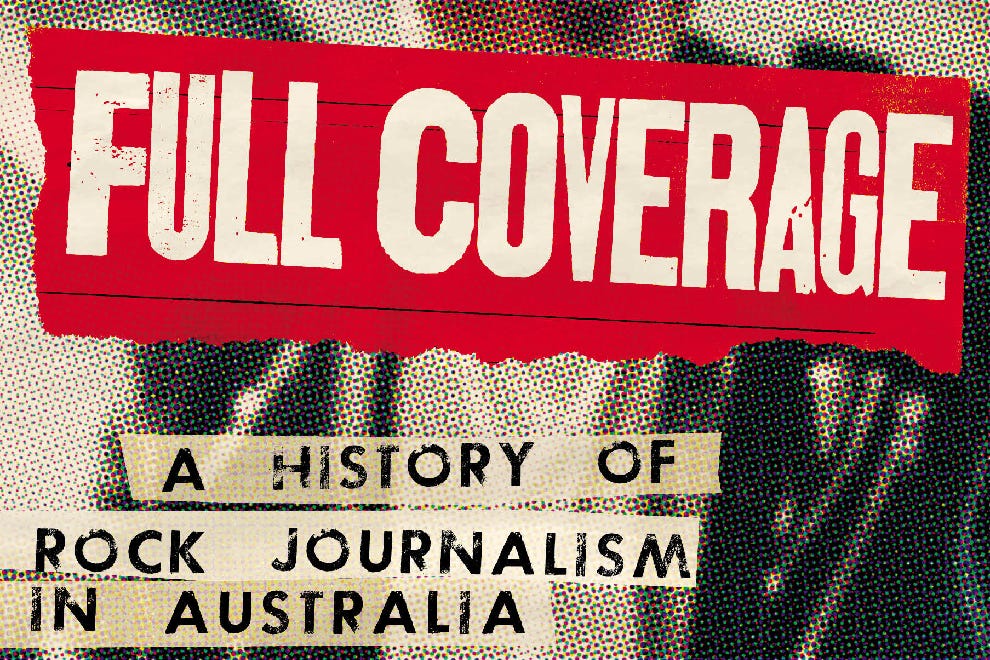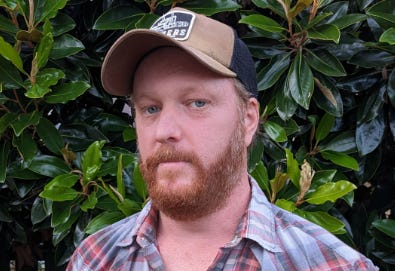So, how's music journalism faring in Australia?
"It seems like it can't get much worse," says a journalist who has just published a book on this exact topic.
I wanted to hear something positive.
I was hoping to get some good news.
I was praying for encouragement.
I wasn’t going to get it.
“A lot of stuff has died off,” Samuel J. Fell told me.
“It’s nothing like it was even three years ago,” he said. “There is one full-time music journalist in Australia working in print.
“I doubt if there'd be anyone … making their living as a freelance music writer.”
Yikes.
I called Fell armed with the same questions I’ve been asking over and over again right here in this newsletter.
What’s happened to music journalism?
Where have all the music journalists gone?
What happens when music journalism disappears?
For Fell, an Australian writer who has just published a book about the history of music journalism in his home country, I had one more question.
Is it as bad in Australia as it is in New Zealand?
It turns out it is.
The morning we spoke, Fell had been touching base with his contacts, hoping to build up his freelance career again after taking a few years off to write his book.
He thought he’d walk back into it, but he wasn’t getting many bites. “It's different now to how it was only a few years ago,” he told me. “It seems like it can’t get much worse.”
I thought Australia might fare better, that its bigger population would mean it was insulated from the issues affecting once-mighty media empires, a situation that has led to the decimation of entertainment journalism across Aotearoa.
As Fell detailed what’s happening across the Tasman, I realised that wasn’t the case at all.
It’s exactly the same over there.
Australia’s popular street press – those weekly magazine freebies distributed in bus stops and train stations that reach tens of thousands of eyeballs – are in decline.
Mainstream media legacy companies like the Sydney Morning Herald and The Age are struggling too. While they haven’t quite deleted their music sections like Stuff did recently, there isn’t much music content to be found in them.
“They have very little music space,” says Fell, who says there’s just one music journalist left standing in print. “Andrew McMillen (at The Australian) is the only one full-time,” he says.
While magazines like Rolling Stone and websites like Tone Deaf remain, Fell says the freelancers that populate those publications with content are struggling too.
“I doubt if there would be anyone doing [it] and not having to supplement their income in another way,” he says. Fell does exactly that, working two days a week in his local Brunswick Heads bottle store.
It wasn’t always like this. Fell should know. Released late last year, his second book details what working as a music journalist in Australia has been like across the past five decades.
Called Full Coverage: A History of Rock Journalism in Australia, it’s been well received by those in the industry. “A sensational history not only of music journalism but also of the cultural times,” is how You Am I singer Tim Rogers describes it.
From his research, Fell believes the 70s and 80s were the best time to be a music journalist. That, he says, is when it began to be taken seriously as an art form.
“You’ve got these editors who, in the wake of these really big serious cultural records like NME, Melody Maker and Rolling Stone, wanted the Australian equivalents to be the same,” he says.
“So they pushed their writers to produce journalism about music with the same seriousness as political, economical or social journalism.”
Fell, ahem, fell into music journalism in the early 2000s when he began working at Melbourne’s Rhythms Magazine, sorting mail and answering phones. He worked his way up, writing reviews for the street rag InPress, then progressing to The Age, SMH and Rolling Stone.
Over the next five years, he became known as Australia’s roots music expert, a go-to for any publication needing content about blues or rock n roll.
It was easy back then to pursue the career he was interested in. “I was the blues writer in Australia. If anything was happening, I would get emails or calls from editors to write something about it,” he says.
Soon, Fell was earning enough to survive, and living the kind of life he’d dreamed of, covering live shows and reviewing festivals regularly. It continued that way, he says, until just before Covid.
Here, in 2024, things are very different.
Many of the publications he used to write for don’t exist.
If they do, they have drastically reduced budgets.
Opportunities to write feature reviews, in-depth profiles and deep-dive journalism – “like a 2000-5000-word feature, intricately researched over three or four months, quoting half a dozen different people, photos, layout, the whole deal” – aren’t there anymore.
In New Zealand, a recent Creative New Zealand research project called New Mirrors examined what happens when culture stops being covered in mainstream media. It found young artists struggled to get their voices heard, to get their names out there, and to establish a career. It also found it was detrimental to writers, who could no longer pursue arts and culture writing as a career because those jobs no longer exist.
Fell’s been wondering what the effects of all this are in Australia, on writers, on fans, and on local artists – especially for rock bands, something the country is known for churning out on a mass scale.
“Take a young band, a bunch of 22-year-olds,” he says. “They’ve just released their first EP so [they might get] a little five-question Q&A. A year later, they’ve released their debut album. They might get a quarter-page, 600-word profile in the front of a magazine. That’s how it’s supposed to go.
“Now, there is absolutely nowhere where that will happen.”
He also wonders what would happen when someone wants to write a book, like the one he’s just finished, about music and music journalism during the 2020s, a time when nostalgia is rife, when music festivals are proliferating, and when demand for live music is at an all-time high.
Where would that information come from?
Fell pauses to contemplate this. No one’s compiling TikToks or Instagram Reels so they can be referenced in the future. So without journalists interviewing artists, documenting festivals, covering things in the same way sports and politics is covered, it would be close to impossible.
“Australia had this dedicated music press holding to account this very robust, well-known music scene. It had that dedicated press growing and working alongside it and has done for 50 years,” he says.
“It’s going to seem like nothing was happening at all.”
Everything you need to know this week…
For the first time in a decade, ticket sales to Coachella are sluggish. More than a week after a throwback 90s line-up was announced with No Doubt, Doja Cat, Tyler the Creator and Lana Del Rey, punters can still get tickets to both weekends – something that hasn’t happened in a long time, reports SF Gate. Is it the line-up? Festival over-saturation? The economic downturn? Thoughts, please.
Like last year’s Limp Bizkit performance, I did not think a Spark Arena show by New Orleans death-rappers $uicideboy$ would sell out. Yet their March 23 performance has very nearly done just that, with just a handful of tickets left. I love that a genre of music getting virtually zero media attention is just bubbling away, doing its thing in the background, then reaching down here to New Zealand and doing massive numbers. (If anyone wants to sell me a GA ticket, I’d love to go.)
It’s been a slow start to the year for concert announcements but a few are beginning to trickle through. Rapper A Boogie Wit Da Hoodie (or ‘Boogie’ for short) is playing Spark Arena on April 10, with tickets on sale from Friday; Chris Isaak is in Wellington’s Michael Fowler Centre on April 22 and Spark Arena on April 24; Benson Boone will play The Powerstation on September 14; and Lyttleton’s March 9 Port Noise festival has announced Mykki Blanco as headliner. Bummer for TLC fans: their show with Busta Rhymes has been canned.
Coming up this week: Chicago post-metallers Russian Circles turn the amps up to 11 at The Tuning Fork tonight; across town, German rockers Milky Chance play a sold out show at the Powerstation; on Friday, Welcome to Nowhere festival kicks off in Whanganui; on Saturday, a multi-stage daytime bike festival called Future Future is happening very near my home with King Kapisi, Julia Deans, Rei and Yoko-Zuna on the bill; and, that same night, Carl Cox headlines Sonorous, a new boutique dance party being held at The Hunting Lodge.
Finally, thanks to everyone who contributed their new music recommendations on Friday. I spent much of my weekend dipping into new (to me) artists like Aprxel, Pip Blom and Passion Mango. I also had a great time listening to the new album from Thom Yorke’s side-project The Smile. Wall of Eyes is equal parts In Rainbows-era Radiohead and 22, A Million-era Bon Iver. These songs take time to unravel, to shed their skins, to reveal themselves. It’s great. I’m deeply into it.
This is a free edition of Boiler Room. To sign up for the full package, including access to the archives, and to support that rare thing – a New Zealand music journalist fighting the good fight – please consider upgrading your subscription.









Timely... https://www.theguardian.com/commentisfree/2024/jan/30/pitchfork-q-music-reviews-critics-songs
To an old timer like me, the passing of NME into rags like Q seemed like the beginning of the end, because the literary stylists were being squeezed out by the PR men. (Coincidentally it was at around this time that the medical literate stopped being literature. In fact the decline in medical publishing - most doctors are paying to publish their research now - might be a useful comparison, It's the only field I've been in where I've been constantly, exhaustingly. interacting with scam artists, pirates, robber barons and computerized bureaucratic overdetermination)., But no one then knew music writing would get this much worse, till the monthlies, Uncut, The Wire and Record Collector, are left holding the fort (but probably make a living gig for few of their contributors outside the editorial team.).
The researchers of the future are going to be looking through the dusty old hard-drives of the fans for their pdfs.
Where might there be there hope? Jessica Hopper published “The First Collection of Criticism by a Living Female Rock Critic,” in 2015 and she's a brilliant, obsessive stylist, so hopefully women won't let themselves become "experts in a dying field" just as it opens up to them. If we're funding women's sports we could subsidize a team of rock critics till the audience loves the game again. Sure it's woke, and excludes us, but it's an angle, and seems like fun to me. And I think rock books will always be read
Me, I'm looking forward to reading "Freaks Out! Weirdos, Misfits and Deviants – The Rise and Fall of Righteous Rock ’n’ Roll" by Luke Haines. No there's a stylist, a veritable Wodehouse of our times.